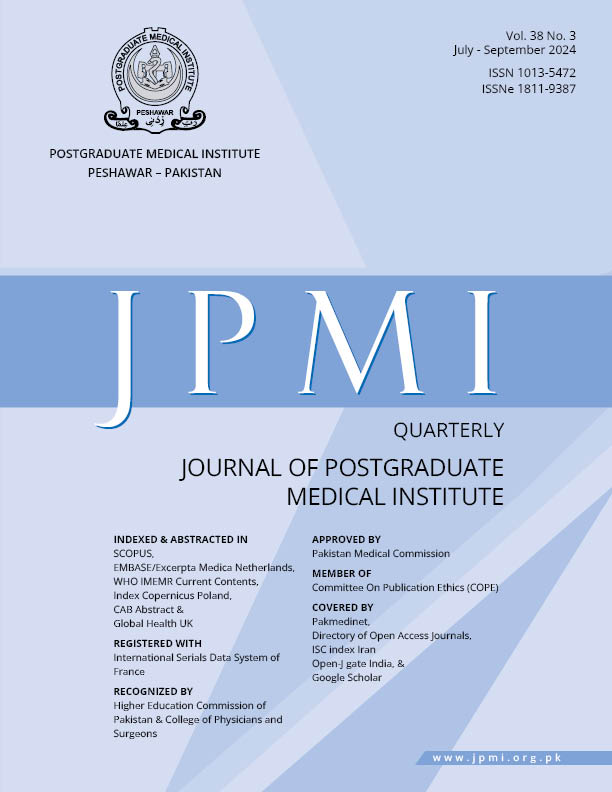Prevalence of Post-Spinal Anesthesia Shivering and Associated Factors in Patients Undergoing Cesarean Section with Spinal Anesthesia in Lady Reading Hospital Peshawar, Pakistan
Main Article Content
Abstract
Objective: To determine the prevalence of Post-spinal anesthesia shivering and associated factors in patients undergoing Cesarean section Surgery in Lady Reading Hospital Peshawar.
Methodology: This observational study was conducted in Lady Reading Hospital Peshawar. One hundred seventy-three patients were included in the study undergoing Spinal Anesthesia for elective or emergency caesarian section from June 2023 to September 2023. ASA class II (American Society of Anesthesiologists) and class III patients were recruited into the study, and non-consenting were excluded. A standard dose of 0.5% bupivacaine was administered as spinal anesthesia and standard monitoring recording was conducted every 5 minutes during the surgery. Shivering was monitored till the discharge of the patient to the ward.
Results: Out of 173 patients included in the study, only 18 surgeries were elective, and the rest, 155, were emergency cesarean section surgeries. Among emergency surgeries, the highest number of indications was Poor progression of labor, 29.6%. Post-spinal anesthesia shivering was recorded in 146 patients, 15.6%. Most of the post-spinal anesthesia was also associated with Hypothermia (92.5%) and hypotension (96.2%).
Conclusion: Post-spinal shivering was observed in 15.6% of the patients, with hypothermia and hypotension as associated factors.
Article Details
Work published in JPMI is licensed under a
Creative Commons Attribution-NonCommercial 2.0 Generic License.
Authors are permitted and encouraged to post their work online (e.g., in institutional repositories or on their website) prior to and during the submission process, as it can lead to productive exchanges, as well as earlier and greater citation of published work.
References
Guyton AC, Hall JE. Adrenocortical Hormones Textbook of Medical Physiology. 11th ED Philadelphia: Elsevier Inc 2006:889–901
Sessler DI. Temperature monitoring and perioperative thermoregulation. Anesthesiol. 2008;109(2):318-38. DOI: 10.1097/ALN.0b013e31817f6d76.
Sessler DI. Mild perioperative hypothermia. N Engl J Med. 1997;336(24):1730–7.
Reynolds L, Beckmann J, Kurz A. Perioperative complications of hypothermia. Best Pract Res Clin Anaesthesiol. 2008;22(4):645–57. DOI: 10.1016/j.bpa.2008.07.005.
Butterworth IV MD, Wasnick JD. Airway management. Morgan & Mikhail's Clinical Anesthesiology. 5th ed. New York: McGraw Hill. 2013:1184–5.
Luggya TS, Kabuye RN, Mijumbi C, Tindimwebwa JB, Kintu A. Prevalence, associated factors and treatment of post spinal shivering in a Sub-Saharan tertiary hospital: a prospective observational study. BMC Anesthesiol. 2016;16(1):100. DOI: 10.1186/s12871-016-0268-0.
Asami T, Hori T, Kiyohara T, Nakashima T. Convergence of thermal signals on the reticulospinal neurons in the midbrain, pons and medulla oblongata. Brain Res Bull. 1988;20(5):581-96. DOI: 10.1016/0361-9230(88)90217-1.
Giesbrecht GG, Sessler DI, Mekjavic IB, Schroeder M, Bristow GW. Treatment of immersion hypothermia by direct body-to- body contact. J Appl Physiol. 1994;76:2373–9. DOI: 10.1152/jappl.1994.76.6.2373.
Javaherforoosh F, Akhondzadeh R, Aein KB, Olapour A, Samimi M. Effects of Tramadol on Shivering post spinal anesthesia in elective cesarean section. Pak J Med Sci. 2009;25(1):12–7.
Crossley AW, Mahajan RP. The intensity of postoperative shivering is unrelated to axillary temperature. Anaesthesia. 1994;49:205–7.
Honarmand A, Safavi MR. Comparison of prophylactic use of midazolam ketamine, and ketamine plus midazolam for prevention of shivering during regional anaesthesia: a randomized double-blind placebo controlled trial. Br J Anaesth. 2008;101:557–62.
Esmat IM, Mohamed MM, Abdelaal WA, El-Hariri HM, Ashoor TM. Postspinal anesthesia shivering in lower abdominal and lower limb surgeries: a randomized controlled comparison between paracetamol and dexamethasone. BMC Anesthesiol. 2021;21:1-3. DOI: 10.1186/s12871-021-01483-7.
Lakhe G, Adhikari KM, Khatri K, Maharjan A, Bajracharya A, Khanal H. Prevention of Shivering during Spinal Anesthesia: Comparison between Tramadol, Ketamine and Ondansetron. J Nepal Med Assoc. 2017;56(208):395-400.
Ferede YA, Aytolign HA, Mersha AT. "The magnitude and associated factors of intraoperative shivering after cesarean section delivery under Spinal anesthesia'': A cross-sectional study. Ann Med Surg (Lond). 2021;72:103022. DOI: 10.1016/j.amsu.2021.103022.
Lopez MB. Postanaesthetic shivering - from pathophysiology to prevention. Romanian J Anaesth Intensive Care. 2018;25(1):73–81.
Luggya TS, Kabuye RN, Mijumbi C, Tindimwebwa JB, Kintu A. Prevalence, associated factors and treatment of post spinal shivering in a Sub-Saharan tertiary hospital: a prospective observational study. BMC Anesthesiol. 2016;16(1):100. DOI: 10.1186/s12871-016-0268-0.
Dal D, Kose A, Honca M, Akinci SB, Basgul E, Aypar U. Efficacy of prophylactic ketamine in preventing postoperative shivering. Br J Anaesth. 2005;95(2):189-92. DOI: 10.1093/bja/aei148.
Sessler DI, Ponte J. Shivering during epidural anesthesia. Anesthesiology. 1990;72(5):816-21. DOI: 10.1097/00000542-199005000-00008.
Kranke P, Eberhart LH, Roewer N, Tramèr MR. Single-dose parenteral pharmacological interventions for the prevention of postoperative shivering: a quantitative systematic review of randomized controlled trials. Anesth Analg. 2004;99(3):718-27. DOI: 10.1213/01.ANE.0000130589.00098.
Kranke P, Eberhart LH, Roewer N, Tramèr MR. Postoperative shivering in children: a review on pharmacologic prevention and treatment. Paediatr Drugs. 2003;5(6):373-83. DOI: 10.2165/00128072-200305060-00003.
Crossley AW. Six months of shivering in a district general hospital. Anaesthesia. 1992;47(10):845-8. DOI: 10.1111/j.1365-2044.1992.tb03143.x.
Zhang Y, Wong KC. Anesthesia and postoperative shivering: its etiology, treatment and prevention. Acta Anaesthesiol Sin. 1999;37(3):115-20.
Lee DS, Shaffer MJ. Low incidence of shivering with chronic propranolol therapy. Lancet. 1986;1(8479):500. DOI: 10.1016/s0140-6736(86)92956-9.
Yimer HT, Hailekiros AG, Tadesse YD. Magnitude and associated factors of postanaesthesia shivering among patients who operated under general and regional anesthesia, Northwest Ethiopia: a cross sectional study. Anesth Clin Res. 2015;6(11):1-5.
Armahizer MJ, Strein M, Pajoumand M. Control of shivering during targeted temperature management. Crit Care Nurs Q. 2020;43(2):251-66. DOI: 10.1097/CNQ.0000000000000305.
Javaherforoosh F, Akhondzadeh R, Aein KB, Olapour A, Samimi M. Effects of tramadol on shivering post spinal anesthesia in elective cesarean section. Pak J Med Sci. 2009;25(1):12-7.


